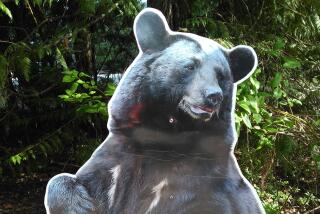Sizing Up Relationship Between Humans and Elephants
- Share via
LOVE, WAR, AND CIRCUSES: The Age-Old Relationship Between Elephants and Humans, By Eric Scigliano, Houghton Mifflin Co., 358 pages, $25
*
Civilization, we all know, has been the severest threat to wildlife. But need it always be so? In the final episode of his inspiring television series, “Civilization,” the British art historian Sir Kenneth Clark, having guided his audience through centuries of painting, sculpture, literature and music, reminded viewers that humans will also be judged by how well we treat other species: “our sisters and brothers,” as he charmingly called them.
It is not only that kindness and decency are the hallmarks of the truly civilized person, but also that other species which inhabit this planet are (like Mayan temples, Impressionist art, Beethoven symphonies, Shakespearean plays) creations worth cherishing.
But being human and being humane are not always the same. Although we pride ourselves on our capacity for foresight, too often we are seduced by short-term goals. The relationship between humans and elephants, as examined by Eric Scigliano in “Love, War, and Circuses,” provides a sobering but not entirely discouraging glimpse not so much into elephants as into us.
Where Shana Alexander’s “The Astonishing Elephant” offered information about everything from elephant sex organs to digestive tracts, Scigliano’s chief interest is in what humans have made of elephants. This includes the use of elephants in war, literature and religion, the slaughter of elephants for ivory, the Asian tradition of elephant handling, elephants in circuses and zoos, a bizarre scheme to revive North America’s Ice Age mammoths via frozen DNA, and the underreported but impressive efforts of conservationists in India, Sri Lanka and Burma to preserve elephants and their environment. Because there have been so many books on the African elephant, Scigliano, who first saw them as a boy in Vietnam, devotes more attention to its smaller cousin, the Asian elephant.
Although not as closely related to humans as the great apes, elephants (like cetaceans and bears) are curiously more appealing to most of us. Stately and dignified in mien, they seem to exude wisdom and benevolence.
Immensely powerful, they are also capable of great gentleness and delicacy. And yes, Scigliano confirms, they have long memories. Not only do they remember friends and hold grudges, they’ve been known to pick up a paintbrush and express themselves artistically.
And they have critical taste, too, judging by a story Scigliano recounts of an elephant ballet choreographed by George Balanchine with music by Igor Stravinsky. Although the elephants danced nicely to waltzes and marches, they reportedly “flapped their ears in pain at the Stravinsky music.”
How the elephant became the Republican Party mascot is another of the many tales recounted in this book. (It began with a political cartoon by Thomas Nast in 1874.) Adlai Stevenson noted the aptness of the identification: “a thick skin, a head full of ivory, and as everyone who has seen a circus parade knows, proceeds best by grasping the tail of its predecessor.”
But life with humans has been more work than play. In Asia, for about 4,000 years, elephants have been used to drag heavy loads. (Scigliano describes how they are still instrumental in harvesting teakwood.)
Over and above this utilitarian role, the Asian elephant figures prominently in Hindu and Buddhist lore. Visiting Sri Lanka, Scigliano notes political campaign ads by the United Nationalist Party, which has made the big beast its symbol: “The Elephant ... is strong enough even to haul a nation out of a rut. Place your trust in the Elephant. He will never let you down.” Although some elephants have been caught in the cross-fire of this nation’s strife between Buddhists and Hindus, Scigliano reports that both sides have tried to avoid harming them. Cash crop agriculture, alas, poses a greater danger, as farmers force the foraging behemoths off their land.
As human population continues to spiral exponentially, will zoos be the only places where future generations encounter them? Some zookeepers are pouring much effort and money into breeding and raising elephants in captivity. Scigliano makes a case that this would be better spent helping conservationists in places such as Burma, India, Sri Lanka and Africa who are working to save the elephants.
“Love, War, and Circuses” is crammed with fascinating material on everything from natural history to religion, but it lacks a central organizing principle and a cohesive narrative. But there’s so much to be said about this gargantuan creature and the role that man and beast have played in each other’s histories, it is difficult to tie it all up into one neat bundle.
More to Read
The biggest entertainment stories
Get our big stories about Hollywood, film, television, music, arts, culture and more right in your inbox as soon as they publish.
You may occasionally receive promotional content from the Los Angeles Times.










